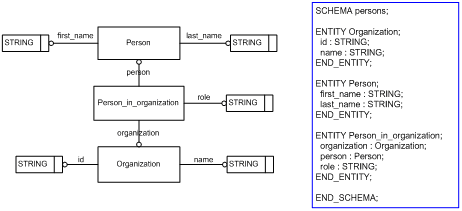 provides a brief overview of ISO 10303
provides a brief overview of ISO 10303 and the parts of it that are relevant to PLCS
and the parts of it that are relevant to PLCS .
.
| Help TOC > PLCS technical description > ISO 10303-239 | |
| ISO 10303-239 | Date: 2008/03/04 21:34:46 Revision: 1.20 |
The technical description of ISO 10303-239 provides a brief overview of ISO 10303
provides a brief overview of ISO 10303 and the parts of it that are relevant to PLCS
and the parts of it that are relevant to PLCS .
.
ISO 10303-239 is part of the ISO 10303 family of standards, generally known as "STEP ".
".
ISO 10303 is an ISO standard for the computer-interpretable representation and exchange of industrial product data. Its official title is Industrial automation systems and integration - Product data representation and exchange, and it is also known as STEP or the STandard for the Exchange of Product model data. The standard's objective is to provide a mechanism that is capable of describing product data throughout the life cycle of a product, independent from any particular system. The nature of this description makes it suitable not only for neutral file exchange, but also as a basis for implementing and sharing product databases and archiving.
ISO 10303 is a multi part standard. The different published standards of 10303 are numbered, starting with 10303-1. By convention the parts are classified by the range in which part number falls. The main categories are:
Source: Wikipedia (http://en.wikipedia.org/wiki/ISO_10303)
Additional information may be found at ISO TC184/SC4 web site : (http://www.tc184-sc4.org/SC4_Open/SC4%20Legacy%20Products%20(2001-08)/STEP_(10303)/)
The following describes where PLCS fits in the ISO 10303 family of standards:
The principal part is ISO 10303-239 Product Life Cycle Support "Application Protocol" This was first published in 2005 and was developed under ISO rules by PLCS Inc, an international consortium established for that purpose. The consortium comprised: US Department of Defense, UK Ministry of Defence, Finnish Defence Forces, Norwegian Ministry of Defence, FMV (Swedish Defence Material Administration), Eurostep Limited, DNV, Boeing, BAE Systems, Rolls-Royce, Lockheed Martin, SAAB, Hägglunds Vehicles, BAAN, LSC, PTC, IFS, EDS, Aerosystems International and Pennant.
The key components of an Application Protocol are the informative Activity Model
are the informative Activity Model (which illustrates the scope and range of the AP)
and the normative information
model (which defines the information flows between the activities).
(which illustrates the scope and range of the AP)
and the normative information
model (which defines the information flows between the activities).
The information model is constructed from a set of
Application Modules (Parts 1000 - ).
These are stand-alone modules that can be reused in different Application Protocols. Those used by ISO 10303-239 are
packaged with it.
(Parts 1000 - ).
These are stand-alone modules that can be reused in different Application Protocols. Those used by ISO 10303-239 are
packaged with it.
Because PLCS is one of the series of Application Protocols, it is numbered sequentially as "part 239" of STEP, and is
therefore sometimes
referred to as AP239 .
.
The information model is defined using the EXPRESS information modelling language (Part ISO 10303-11).
See: (http://en.wikipedia.org/wiki/ISO_10303-11)
information modelling language (Part ISO 10303-11).
See: (http://en.wikipedia.org/wiki/ISO_10303-11)
ISO 10303 defines two different file transfer formats: I0303-21 ("Part 21")
(see (http://en.wikipedia.org/wiki/ISO_10303-21))
and I0303-28 ("Part 28") (see (http://en.wikipedia.org/wiki/ISO_10303-28))
Part 21 specifies an ASCII exchange file format, whereas Part 28 specifies various
XML exchange file formats. Part 28 edition 2 (used by PLCS) specifies an XML Schema
exchange file formats. Part 28 edition 2 (used by PLCS) specifies an XML Schema based format.
based format.
The scope of ISO 10303-239 PLCS is to "provide through life support for product". The activity model defines four major activities, which are then further broken down:
The AP239 information model details the data structures that are exchanged - i.e. the information that is required by or may be used in these activities - and represents these data structures using EXPRESS entities, attributes, and relationships. (As has been noted, these data structures have been created as Modules that are reused by other Application Protocols.)
For example, in ISO 10303-239 PLCS there are entities that define: parts that make up a product (Part), versions of parts (Part_versions), and people (Person). Each entity may have attributes that provide further information about the object being represented. For example, a person has a first name and last name. Correspondingly, the Person entity has first_name and last_name attributes. Entities may also have relationships to other entities, e.g. a person may work in an organization.
The diagram in Figure 1 presents a graphical representation of EXPRESS (EXPRESS-G ) alongside a lexical representation (EXPRESS),
for a number of example entities, attributes, and relationships.
) alongside a lexical representation (EXPRESS),
for a number of example entities, attributes, and relationships.

The AP239 EXPRESS information model is the core component of the PLCS standard.